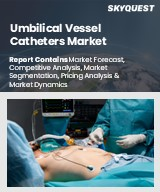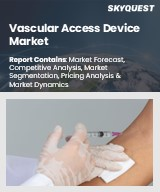
|
시장보고서
상품코드
1820121
세계의 카테터 시장 보고서 : 제품 유형별, 최종 사용자별, 지역별(2025-2033년)Catheters Market Report by Product Type, End User, and Region 2025-2033 |
||||||
세계의 카테터 시장 규모는 2024년 238억 달러에 달했습니다. IMARC Group은 향후 시장이 2033년에는 447억 달러에 이를 전망이며, 2025-2033년 성장률(CAGR) 6.88%로 성장할 것으로 예측했습니다.
카테터는 치료와 진단을 위해 환자의 몸에 삽입되는 얇은 튜브입니다. 플라스틱, 실리콘 고무, 라텍스, PVC(PVC), 나일론과 같은 의료 등급 재료를 사용하여 제조됩니다. 일반적으로 사용되는 것에는 심장혈관용, 신경혈관용, 비뇨기용, 정맥용, 특수용 등이 있습니다. 또한 급성기 의료 시설에서는 수술 중이나 수술 후 회복기에 소변 등 체액의 배출을 감시 및 관리하기 위해 사용됩니다. 그 결과, 카테터는 다양한 신경혈관, 비뇨기, 심장혈관 장애의 치료에 광범위하게 응용되고 있습니다.
세계적으로 비뇨기 질환의 유병률이 증가하고 있는 것은 시장 성장을 가속하는 중요한 요인 중 하나입니다. 게다가 이러한 질병에 걸리기 쉬운 노인 인구가 증가하고 있으며, 침습 수술(MI)에 대한 선호도가 높아지고 있는 것도 시장 성장을 뒷받침하고 있습니다. 이 카테터는 병원, 클리닉 및 기타 헬스케어 센터에서 심장에 들어가는 혈관의 전기적 활동을 측정하기 위해 와이어 전극을 삽입하는 전기 생리학적 치료에도 널리 사용됩니다. 또한 로봇 지원에 의한 외과 수술의 이용 등 다양한 기술의 진보도 성장을 가속하는 요인이 되고 있습니다. 이에 따라 카테터 관련 감염 및 혈전증의 발생을 최소화하기 위한 은 이온 코팅을 실시한 항균성 카테터의 제조가 시장 성장을 뒷받침하고 있습니다. 기타 요인으로는 의료 치료에 대한 사람들의 지출 능력 상승, 헬스케어 인프라의 대폭적인 개선 등을 들 수 있으며, 시장 성장의 원동력이 될 것으로 예측됩니다.
이 보고서에서 다루는 주요 질문
- 세계의 카테터 시장은 지금까지 어떻게 추이했으며, 향후 어떻게 추이해 갈 것인가?
- 세계의 카테터 시장에 준 COVID-19의 영향은?
- 주요 지역 시장은?
- 제품 유형별 시장 내역은?
- 최종 사용자별 시장 내역은?
- 업계 밸류체인의 다양한 단계란?
- 업계의 주요 촉진요인 및 과제는 무엇인가?
- 세계 카테터 시장의 구조 및 주요 기업은?
- 업계의 경쟁 정도는?
목차
제1장 서문
제2장 조사 범위 및 조사 방법
- 조사의 목적
- 이해관계자
- 데이터 소스
- 1차 정보
- 2차 정보
- 시장 추정
- 상향식 접근
- 하향식 접근
- 예측 기법
제3장 주요 요약
제4장 서문
제5장 세계의 카테터 시장
- 시장 개요
- 시장 실적
- COVID-19의 영향
- 시장 예측
제6장 시장 내역 : 제품 유형별
- 심장혈관계 카테터
- 비뇨기 카테터
- 정맥내 카테터
- 신경혈관 카테터
- 전문분야 카테터
- 기타
제7장 시장 내역 : 최종 사용자별
- 병원 및 진료소
- 외래수술센터(ASC)
- 기타
제8장 시장 내역 : 지역별
- 북미
- 미국
- 캐나다
- 아시아태평양
- 중국
- 일본
- 인도
- 한국
- 호주
- 인도네시아
- 기타
- 유럽
- 독일
- 프랑스
- 영국
- 이탈리아
- 스페인
- 러시아
- 기타
- 라틴아메리카
- 브라질
- 멕시코
- 기타
- 중동 및 아프리카
제9장 SWOT 분석
제10장 밸류체인 분석
제11장 Porter's Five Forces 분석
제12장 가격 분석
제13장 경쟁 구도
- 시장 구조
- 주요 기업
- 주요 기업 프로파일
- Abbott Laboratories
- B. Braun Melsungen AG
- Becton Dickinson and Company
- Boston Scientific Corporation
- Coloplast Corporation
- ConvaTec Group PLC
- Edwards Lifesciences Corporation
- Hollister Incorporated
- Johnson & Johnson
- Medtronic plc
- Stryker Corporation
- Teleflex Incorporated
The global catheters market size reached USD 23.8 Billion in 2024. Looking forward, IMARC Group expects the market to reach USD 44.7 Billion by 2033, exhibiting a growth rate (CAGR) of 6.88% during 2025-2033.
A catheter is a thin tube inserted into the patient's body for therapeutic and diagnostic applications. It is manufactured using medical-grade materials, such as plastic, silicone rubbers, latex, polyvinyl chloride (PVC) and nylon. Some of the commonly available variants include cardiovascular, neurovascular, urinary, intravenous and specialty catheters. They are used to deliver medicines and gases into the bodies and are also used in acute care facilities to monitor and manage drainage of bodily fluids, such as urine, during surgery and post-operative recovery. As a result, catheters find extensive applications in the treatment of various neurovascular, urological and cardiovascular disorders.
The increasing prevalence of urological disorders across the globe is one of the key factors driving the growth of the market. Furthermore, the rising geriatric population, which is more susceptible to such ailments and the increasing preference for minimally invasive surgeries (MI) are providing a thrust to the market growth. These catheters are also widely used in hospitals, clinics and other healthcare centers for electrophysiological procedures that use catheters to insert wire electrodes to measure electrical activity in the blood vessels entering the heart. Additionally, various technological advancements, such as the utilization of robot-assisted surgical interventions, are acting as other growth-inducing factors. In line with this, the manufacturing of anti-microbial catheters with silver ion coatings to minimize the incidence of catheter-associated infections and thrombosis, which is favoring the market growth. Other factors, including rising expenditure capacities of the masses on medical procedures, along with significant improvements in the healthcare infrastructure, are anticipated to drive the market toward growth.
Key Market Segmentation:
Breakup by Product Type:
- Cardiovascular Catheters
- Urology Catheters
- Intravenous Catheters
- Neurovascular Catheters
- Specialty Catheters
- Others
Breakup by End User:
- Hospitals and Clinics
- Ambulatory Surgical Centers
- Others
Breakup by Region:
- North America
- United States
- Canada
- Asia-Pacific
- China
- Japan
- India
- South Korea
- Australia
- Indonesia
- Others
- Europe
- Germany
- France
- United Kingdom
- Italy
- Spain
- Russia
- Others
- Latin America
- Brazil
- Mexico
- Others
- Middle East and Africa
Competitive Landscape:
The competitive landscape of the industry has also been examined along with the profiles of the key players being Abbott Laboratories, B. Braun Melsungen AG, Becton Dickinson and Company, Boston Scientific Corporation, Coloplast Corporation, ConvaTec Group PLC, Edwards Lifesciences Corporation, Hollister Incorporated, Johnson & Johnson, Medtronic plc, Stryker Corporation and Teleflex Incorporated.
Key Questions Answered in This Report:
- How has the global catheters market performed so far and how will it perform in the coming years?
- What has been the impact of COVID-19 on the global catheters market?
- What are the key regional markets?
- What is the breakup of the market based on the product type?
- What is the breakup of the market based on the end user?
- What are the various stages in the value chain of the industry?
- What are the key driving factors and challenges in the industry?
- What is the structure of the global catheters market and who are the key players?
- What is the degree of competition in the industry?
Table of Contents
1 Preface
2 Scope and Methodology
- 2.1 Objectives of the Study
- 2.2 Stakeholders
- 2.3 Data Sources
- 2.3.1 Primary Sources
- 2.3.2 Secondary Sources
- 2.4 Market Estimation
- 2.4.1 Bottom-Up Approach
- 2.4.2 Top-Down Approach
- 2.5 Forecasting Methodology
3 Executive Summary
4 Introduction
- 4.1 Overview
- 4.2 Key Industry Trends
5 Global Catheters Market
- 5.1 Market Overview
- 5.2 Market Performance
- 5.3 Impact of COVID-19
- 5.4 Market Forecast
6 Market Breakup by Product Type
- 6.1 Cardiovascular Catheters
- 6.1.1 Market Trends
- 6.1.2 Market Forecast
- 6.2 Urology Catheters
- 6.2.1 Market Trends
- 6.2.2 Market Forecast
- 6.3 Intravenous Catheters
- 6.3.1 Market Trends
- 6.3.2 Market Forecast
- 6.4 Neurovascular Catheters
- 6.4.1 Market Trends
- 6.4.2 Market Forecast
- 6.5 Specialty Catheters
- 6.5.1 Market Trends
- 6.5.2 Market Forecast
- 6.6 Others
- 6.6.1 Market Trends
- 6.6.2 Market Forecast
7 Market Breakup by End User
- 7.1 Hospitals and Clinics
- 7.1.1 Market Trends
- 7.1.2 Market Forecast
- 7.2 Ambulatory Surgical Centers
- 7.2.1 Market Trends
- 7.2.2 Market Forecast
- 7.3 Others
- 7.3.1 Market Trends
- 7.3.2 Market Forecast
8 Market Breakup by Region
- 8.1 North America
- 8.1.1 United States
- 8.1.1.1 Market Trends
- 8.1.1.2 Market Forecast
- 8.1.2 Canada
- 8.1.2.1 Market Trends
- 8.1.2.2 Market Forecast
- 8.1.1 United States
- 8.2 Asia-Pacific
- 8.2.1 China
- 8.2.1.1 Market Trends
- 8.2.1.2 Market Forecast
- 8.2.2 Japan
- 8.2.2.1 Market Trends
- 8.2.2.2 Market Forecast
- 8.2.3 India
- 8.2.3.1 Market Trends
- 8.2.3.2 Market Forecast
- 8.2.4 South Korea
- 8.2.4.1 Market Trends
- 8.2.4.2 Market Forecast
- 8.2.5 Australia
- 8.2.5.1 Market Trends
- 8.2.5.2 Market Forecast
- 8.2.6 Indonesia
- 8.2.6.1 Market Trends
- 8.2.6.2 Market Forecast
- 8.2.7 Others
- 8.2.7.1 Market Trends
- 8.2.7.2 Market Forecast
- 8.2.1 China
- 8.3 Europe
- 8.3.1 Germany
- 8.3.1.1 Market Trends
- 8.3.1.2 Market Forecast
- 8.3.2 France
- 8.3.2.1 Market Trends
- 8.3.2.2 Market Forecast
- 8.3.3 United Kingdom
- 8.3.3.1 Market Trends
- 8.3.3.2 Market Forecast
- 8.3.4 Italy
- 8.3.4.1 Market Trends
- 8.3.4.2 Market Forecast
- 8.3.5 Spain
- 8.3.5.1 Market Trends
- 8.3.5.2 Market Forecast
- 8.3.6 Russia
- 8.3.6.1 Market Trends
- 8.3.6.2 Market Forecast
- 8.3.7 Others
- 8.3.7.1 Market Trends
- 8.3.7.2 Market Forecast
- 8.3.1 Germany
- 8.4 Latin America
- 8.4.1 Brazil
- 8.4.1.1 Market Trends
- 8.4.1.2 Market Forecast
- 8.4.2 Mexico
- 8.4.2.1 Market Trends
- 8.4.2.2 Market Forecast
- 8.4.3 Others
- 8.4.3.1 Market Trends
- 8.4.3.2 Market Forecast
- 8.4.1 Brazil
- 8.5 Middle East and Africa
- 8.5.1 Market Trends
- 8.5.2 Market Breakup by Country
- 8.5.3 Market Forecast
9 SWOT Analysis
- 9.1 Overview
- 9.2 Strengths
- 9.3 Weaknesses
- 9.4 Opportunities
- 9.5 Threats
10 Value Chain Analysis
11 Porters Five Forces Analysis
- 11.1 Overview
- 11.2 Bargaining Power of Buyers
- 11.3 Bargaining Power of Suppliers
- 11.4 Degree of Competition
- 11.5 Threat of New Entrants
- 11.6 Threat of Substitutes
12 Price Analysis
13 Competitive Landscape
- 13.1 Market Structure
- 13.2 Key Players
- 13.3 Profiles of Key Players
- 13.3.1 Abbott Laboratories
- 13.3.1.1 Company Overview
- 13.3.1.2 Product Portfolio
- 13.3.1.3 Financials
- 13.3.1.4 SWOT Analysis
- 13.3.2 B. Braun Melsungen AG
- 13.3.2.1 Company Overview
- 13.3.2.2 Product Portfolio
- 13.3.2.3 SWOT Analysis
- 13.3.3 Becton Dickinson and Company
- 13.3.3.1 Company Overview
- 13.3.3.2 Product Portfolio
- 13.3.3.3 Financials
- 13.3.3.4 SWOT Analysis
- 13.3.4 Boston Scientific Corporation
- 13.3.4.1 Company Overview
- 13.3.4.2 Product Portfolio
- 13.3.4.3 Financials
- 13.3.4.4 SWOT Analysis
- 13.3.5 Coloplast Corporation
- 13.3.5.1 Company Overview
- 13.3.5.2 Product Portfolio
- 13.3.5.3 Financials
- 13.3.5.4 SWOT Analysis
- 13.3.6 ConvaTec Group PLC
- 13.3.6.1 Company Overview
- 13.3.6.2 Product Portfolio
- 13.3.6.3 Financials
- 13.3.7 Edwards Lifesciences Corporation
- 13.3.7.1 Company Overview
- 13.3.7.2 Product Portfolio
- 13.3.7.3 Financials
- 13.3.7.4 SWOT Analysis
- 13.3.8 Hollister Incorporated
- 13.3.8.1 Company Overview
- 13.3.8.2 Product Portfolio
- 13.3.8.3 SWOT Analysis
- 13.3.9 Johnson & Johnson
- 13.3.9.1 Company Overview
- 13.3.9.2 Product Portfolio
- 13.3.9.3 Financials
- 13.3.9.4 SWOT Analysis
- 13.3.10 Medtronic plc
- 13.3.10.1 Company Overview
- 13.3.10.2 Product Portfolio
- 13.3.11 Stryker Corporation
- 13.3.11.1 Company Overview
- 13.3.11.2 Product Portfolio
- 13.3.11.3 Financials
- 13.3.11.4 SWOT Analysis
- 13.3.12 Teleflex Incorporated
- 13.3.12.1 Company Overview
- 13.3.12.2 Product Portfolio
- 13.3.12.3 Financials
- 13.3.12.4 SWOT Analysis
- 13.3.1 Abbott Laboratories



















